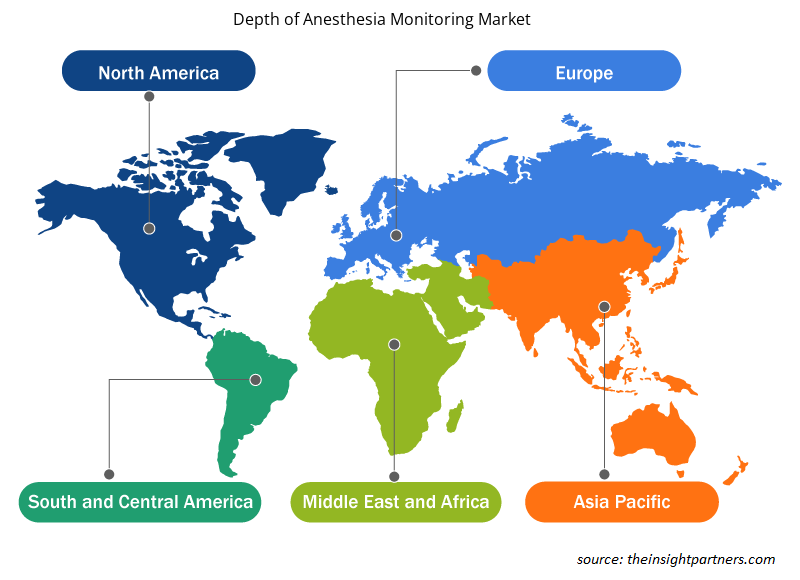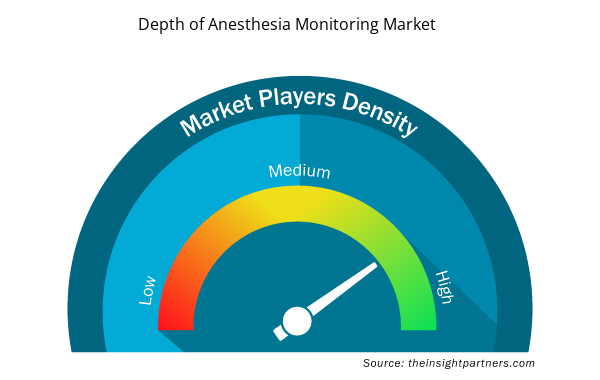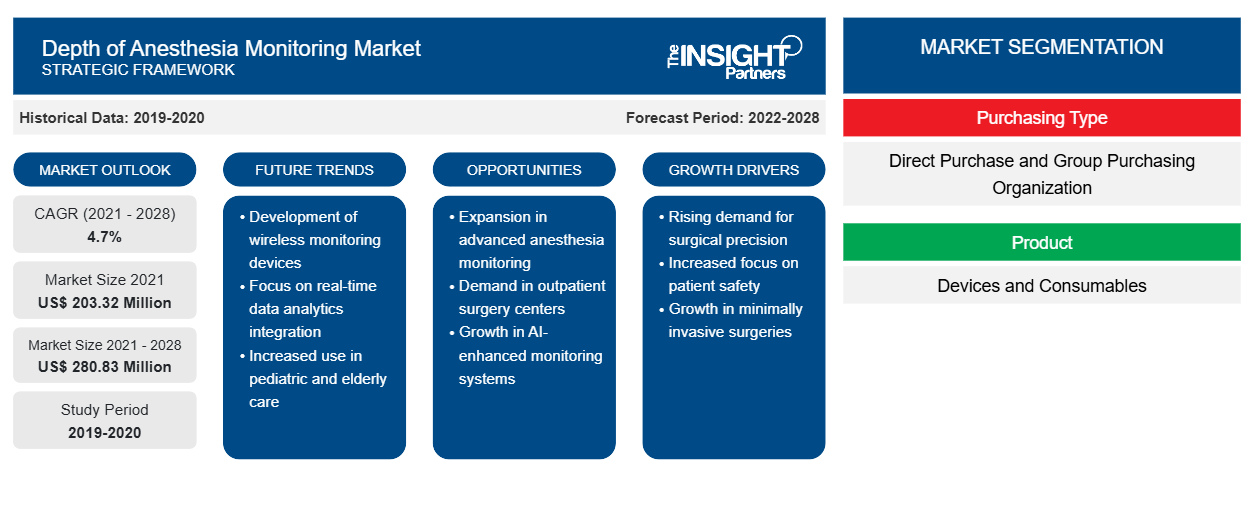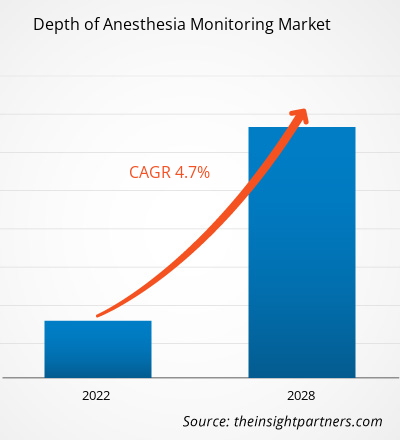[研究报告] 麻醉深度监测市场规模预计将从 2021 年的 2.0332 亿美元增至 2028 年的 2.8083 亿美元。预计 2021 年至 2028 年的复合年增长率为 4.7%。
外科手术数量的增加极大地推动了麻醉监测市场的深度。预测期内,北美很可能继续占据市场主导地位。美国在 2021 年占据了北美市场的最大份额,预计在预测期内将继续保持这一趋势。预计技术进步的采用率不断提高和研发活动的增加将加速市场增长。此外,大型医疗保健企业的存在导致麻醉深度监测的采用率不断提高。
麻醉监测市场的深度根据购买类型、产品、最终用户和地理位置进行细分。按地理位置划分,市场大致分为北美、欧洲、亚太地区、中东和非洲以及南美和中美洲。该报告提供了对市场的深入分析和见解,强调了市场规模、趋势、技术进步和市场动态等参数,并分析了全球领先市场参与者的竞争格局。
定制此报告以满足您的需求
您可以免费定制任何报告,包括本报告的部分内容、国家级分析、Excel 数据包,以及为初创企业和大学提供优惠和折扣
- 获取此报告的关键市场趋势。这个免费样品将包括数据分析,从市场趋势到估计和预测。
市场洞察
外科手术数量的增加推动麻醉监测市场深度发展
糖尿病、心血管疾病、癌症、中风、膀胱癌、前列腺癌、肾脏疾病和其他慢性疾病的患病率不断上升,与全球外科手术数量的增加有关。根据美国麻醉师协会发布的数据,2019年,90%的院内手术在美国53%的医院中进行。此外,美国代谢与减肥外科协会的一项研究表明,2019年美国进行了约252,000例减肥手术。此外,美国麻醉师协会报告称,2019年美国实施的外科手术总数为2830万例。其中,肌肉骨骼和结缔组织、循环系统和消化系统手术是住院手术中最多的,分别占2019年所有住院手术的37%、22%和8%。此外,88% 的医院提供患者自控镇痛,67% 的医院提供疼痛管理治疗。因此,使用全身麻醉的手术数量不断增加是麻醉深度监测市场增长的主要因素。
基于采购类型的洞察
根据采购类型,麻醉深度监测市场分为直接采购和团体采购组织 (GPO)。2021 年,直接采购部分占据了麻醉深度监测市场的更大份额。此外,预计同一细分市场在预测期内的复合年增长率会更高。直接采购可以见证麻醉深度监测设备供应链的上升趋势。大型医院可能会在未来几年选择直接渠道,因为直接采购是整个医疗机构采购设备和耗材的主要来源。随着医疗保健成本的增加,供应商正专注于为客户提供更好的服务,同时降低总体成本。通过直接招标采购设备和耗材对医疗保健提供者来说非常划算,因为它们是根据服务合同条款购买的。此外,在一些国家,团体采购组织的采用率和普及率较低;在许多国家,团体采购组织正处于进入市场的阶段。因此,上述因素将在预测期内促进细分市场的增长。
基于产品的见解
根据产品,麻醉深度监测市场分为设备和耗材。设备部分在麻醉深度监测市场占有相当大的份额,预计在预测期内将继续占据主导地位。设备部分将大幅增长,因为设备是医疗保健提供商(包括医院、诊所和门诊手术中心)功能和成本中心的主要组成部分,因为医疗保健机构在最先进的设备上的支出最高,以实现高效的流程、患者满意度并获得竞争优势。供应商还关注高质量的监测设备,因为它们可以提高护理和工作流程的整体质量。因此,上述因素将为该领域的更广泛采用铺平道路,并有利于麻醉深度监测市场的增长。
麻醉深度监测市场区域洞察
Insight Partners 的分析师已详尽解释了预测期内影响麻醉深度监测市场的区域趋势和因素。本节还讨论了北美、欧洲、亚太地区、中东和非洲以及南美和中美洲的麻醉深度监测市场细分和地理位置。

- 获取麻醉监测市场深度的区域具体数据
麻醉监测市场深度报告范围
| 报告属性 | 细节 |
|---|---|
| 2021 年市场规模 | 2.0332亿美元 |
| 2028 年市场规模 | 2.8083亿美元 |
| 全球复合年增长率(2021 - 2028) | 4.7% |
| 史料 | 2019-2020 |
| 预测期 | 2022-2028 |
| 涵盖的领域 | 按采购类型
|
| 覆盖地区和国家 | 北美
|
| 市场领导者和主要公司简介 |
|
麻醉深度监测市场参与者密度:了解其对业务动态的影响
麻醉深度监测市场正在快速增长,这得益于终端用户需求的不断增长,而这些需求又源于消费者偏好的不断变化、技术进步以及对产品优势的认识不断提高等因素。随着需求的增加,企业正在扩大其产品范围,进行创新以满足消费者的需求,并利用新兴趋势,从而进一步推动市场增长。
市场参与者密度是指在特定市场或行业内运营的企业或公司的分布情况。它表明在给定市场空间中,相对于其规模或总市场价值,有多少竞争对手(市场参与者)存在。
在麻醉深度监测市场运营的主要公司有:
- 深圳迈瑞生物医疗电子股份有限公司
- 美敦力
- 通用电气医疗
- 马西莫
- 荷兰皇家飞利浦公司
免责声明:上面列出的公司没有按照任何特定顺序排列。

- 了解麻醉深度监测市场的主要参与者概况
基于最终用户的洞察
根据最终用户,麻醉监测市场深度细分为医院、门诊手术中心、诊所和其他。医院部门在 2021 年占据了最大的市场份额,并且很可能在预测期内继续占据主导地位。拥有技术先进的设备和仪器以满足大量人群的需求,最大限度地提高患者的舒适度,主要参与者倾向于在医院销售其设备,拥有先进的基础设施,医院拥有熟练的人员,以及医院程序的优惠报销规则,这些都有助于医院部门实现丰厚的增长。
产品发布和批准是公司扩大全球影响力和产品组合最常用的策略之一。市场参与者还专注于合作战略以扩大客户群,这反过来又使他们能够在全球范围内保持自己的品牌名称。他们的目标是通过开发创新产品来扩大市场份额。深圳迈瑞生物医疗电子股份有限公司、美敦力、通用电气医疗集团、Masimo、荷兰皇家飞利浦、福田电子、3M、Danmeter APS、Spacelabs Healthcare 和 Mennen Medical 是麻醉监测市场深度运营的领先公司。
- 历史分析(2 年)、基准年、预测(7 年)及复合年增长率
- PEST 和 SWOT 分析
- 市场规模价值/数量 - 全球、区域、国家
- 行业和竞争格局
- Excel 数据集



Report Coverage
Revenue forecast, Company Analysis, Industry landscape, Growth factors, and Trends

Segment Covered
This text is related
to segments covered.

Regional Scope
North America, Europe, Asia Pacific, Middle East & Africa, South & Central America

Country Scope
This text is related
to country scope.
常见问题
increasing number of surgical procedures and growing employment rate of anesthesia professionals are the most significant factors responsible for the overall market growth.
Based on product, devices segment took the forefront lead in the worldwide market by accounting largest share in 2020 and is expected to continue to do so till the forecast period.
Shenzhen Mindray Bio-medical Electronics Co., Ltd, Medtronic, GE Healthcare, Mennen Medical Ltd., Masimo Corporation, Koninklijke Philips N.V., Spacelabs Healthcare, 3M, Danmeter APS, and Fukuda Denshi are among the leading companies operating in the global depth of anesthesia monitoring market
New surgical procedures, increasing prevalence of day surgery and pressure to deliver "value for money" all influence the choice of drugs and techniques for anesthesia. Advanced monitoring of drug effect might help to optimize quality of drug delivery, possibly by reducing costs and improve patient outcomes.
Global depth of anesthesia monitoring market is segmented by region into North America, Europe, Asia Pacific, Middle East & Africa, and South & Central America. In North America, the U.S. is the largest market for depth of anesthesia monitoring market. The US is estimated to hold the largest share in the depth of anesthesia monitoring market during the forecast period. Increasing adoption of technological advancements and rising research and development activities are projected to accelerate the growth of the depth of anesthesia monitoring market. Additionally, advancing healthcare infrastructure is the contributing factor for the depth of anesthesia monitoring growth in APAC region is the key factor responsible for the Asia-Pacific regional growth for depth of anesthesia monitoring accounting fastest growth of the region during the coming years.
The hospitals segment dominated the global depth of anesthesia monitoring market and accounted for the largest market share of 42.71% in 2021.
Trends and growth analysis reports related to Life Sciences : READ MORE..
The List of Companies - Depth of Anesthesia Monitoring Market
- Shenzhen Mindray Bio-Medical Electronics Co., Ltd.
- Medtronic
- GE Healthcare
- Masimo
- Koninklijke Philips N.V.
- FUKUDA DENSHI
- 3M
- Danmeter APS
- Spacelabs Healthcare
- Mennen Medical
The Insight Partners performs research in 4 major stages: Data Collection & Secondary Research, Primary Research, Data Analysis and Data Triangulation & Final Review.
- Data Collection and Secondary Research:
As a market research and consulting firm operating from a decade, we have published and advised several client across the globe. First step for any study will start with an assessment of currently available data and insights from existing reports. Further, historical and current market information is collected from Investor Presentations, Annual Reports, SEC Filings, etc., and other information related to company’s performance and market positioning are gathered from Paid Databases (Factiva, Hoovers, and Reuters) and various other publications available in public domain.
Several associations trade associates, technical forums, institutes, societies and organization are accessed to gain technical as well as market related insights through their publications such as research papers, blogs and press releases related to the studies are referred to get cues about the market. Further, white papers, journals, magazines, and other news articles published in last 3 years are scrutinized and analyzed to understand the current market trends.
- Primary Research:
The primarily interview analysis comprise of data obtained from industry participants interview and answers to survey questions gathered by in-house primary team.
For primary research, interviews are conducted with industry experts/CEOs/Marketing Managers/VPs/Subject Matter Experts from both demand and supply side to get a 360-degree view of the market. The primary team conducts several interviews based on the complexity of the markets to understand the various market trends and dynamics which makes research more credible and precise.
A typical research interview fulfils the following functions:
- Provides first-hand information on the market size, market trends, growth trends, competitive landscape, and outlook
- Validates and strengthens in-house secondary research findings
- Develops the analysis team’s expertise and market understanding
Primary research involves email interactions and telephone interviews for each market, category, segment, and sub-segment across geographies. The participants who typically take part in such a process include, but are not limited to:
- Industry participants: VPs, business development managers, market intelligence managers and national sales managers
- Outside experts: Valuation experts, research analysts and key opinion leaders specializing in the electronics and semiconductor industry.
Below is the breakup of our primary respondents by company, designation, and region:

Once we receive the confirmation from primary research sources or primary respondents, we finalize the base year market estimation and forecast the data as per the macroeconomic and microeconomic factors assessed during data collection.
- Data Analysis:
Once data is validated through both secondary as well as primary respondents, we finalize the market estimations by hypothesis formulation and factor analysis at regional and country level.
- Macro-Economic Factor Analysis:
We analyse macroeconomic indicators such the gross domestic product (GDP), increase in the demand for goods and services across industries, technological advancement, regional economic growth, governmental policies, the influence of COVID-19, PEST analysis, and other aspects. This analysis aids in setting benchmarks for various nations/regions and approximating market splits. Additionally, the general trend of the aforementioned components aid in determining the market's development possibilities.
- Country Level Data:
Various factors that are especially aligned to the country are taken into account to determine the market size for a certain area and country, including the presence of vendors, such as headquarters and offices, the country's GDP, demand patterns, and industry growth. To comprehend the market dynamics for the nation, a number of growth variables, inhibitors, application areas, and current market trends are researched. The aforementioned elements aid in determining the country's overall market's growth potential.
- Company Profile:
The “Table of Contents” is formulated by listing and analyzing more than 25 - 30 companies operating in the market ecosystem across geographies. However, we profile only 10 companies as a standard practice in our syndicate reports. These 10 companies comprise leading, emerging, and regional players. Nonetheless, our analysis is not restricted to the 10 listed companies, we also analyze other companies present in the market to develop a holistic view and understand the prevailing trends. The “Company Profiles” section in the report covers key facts, business description, products & services, financial information, SWOT analysis, and key developments. The financial information presented is extracted from the annual reports and official documents of the publicly listed companies. Upon collecting the information for the sections of respective companies, we verify them via various primary sources and then compile the data in respective company profiles. The company level information helps us in deriving the base number as well as in forecasting the market size.
- Developing Base Number:
Aggregation of sales statistics (2020-2022) and macro-economic factor, and other secondary and primary research insights are utilized to arrive at base number and related market shares for 2022. The data gaps are identified in this step and relevant market data is analyzed, collected from paid primary interviews or databases. On finalizing the base year market size, forecasts are developed on the basis of macro-economic, industry and market growth factors and company level analysis.
- Data Triangulation and Final Review:
The market findings and base year market size calculations are validated from supply as well as demand side. Demand side validations are based on macro-economic factor analysis and benchmarks for respective regions and countries. In case of supply side validations, revenues of major companies are estimated (in case not available) based on industry benchmark, approximate number of employees, product portfolio, and primary interviews revenues are gathered. Further revenue from target product/service segment is assessed to avoid overshooting of market statistics. In case of heavy deviations between supply and demand side values, all thes steps are repeated to achieve synchronization.
We follow an iterative model, wherein we share our research findings with Subject Matter Experts (SME’s) and Key Opinion Leaders (KOLs) until consensus view of the market is not formulated – this model negates any drastic deviation in the opinions of experts. Only validated and universally acceptable research findings are quoted in our reports.
We have important check points that we use to validate our research findings – which we call – data triangulation, where we validate the information, we generate from secondary sources with primary interviews and then we re-validate with our internal data bases and Subject matter experts. This comprehensive model enables us to deliver high quality, reliable data in shortest possible time.


 获取此报告的免费样本
获取此报告的免费样本